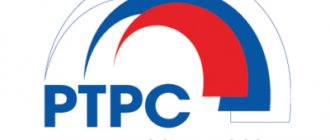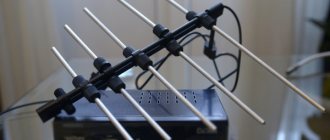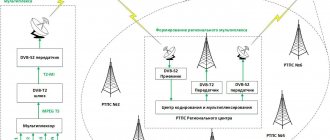Now almost all residents of the country have access to 20 digital channels of Russian television, and plans are underway to launch a third multiplex. However, there is no official data on the start of the broadcast, and some sources claim that it will begin work after the analogue broadcast stops. Below information will help reveal the details of the 3rd multiplex: when it will be launched, what TV channels will broadcast, etc.
Third multiplex
Today in Russia there are officially two digital TV multiplexes. Each digital package includes 10 federal and regional programs on various topics. This is due to the limitation of the amount of packet data that can be broadcast in the T-2 (DVB-T2) standard on one frequency and received on one physical TVC.
The third multiplex is included in plans for the development of digital TV in Russia. However, there is no official information about the start of its work, and the planned launch date has not been set. In practice, the broadcast is already carried out from the Ostankino TV tower and the 3rd package of TV channels is available to all residents of the Moscow region. At the moment, this is the only source of the third digital TV package in Russia and not a single repeater has been installed yet.
The main problems in the development of the 3rd multiplex
To launch the third package, the support of the same technologies as the first 20 TV channels is needed and its distribution could potentially begin at any time. However, at the moment there are limitations that are slowing factors:
- Analogue broadcasting. Standard terrestrial broadcasting occupies the entire meter wavelength range, and the decimeter wavelength is not enough to broadcast 30 programs throughout the entire territory. Today, many TV channels are planning to stop analogue broadcasting, but there is no single program, and frequencies are slowly being released. This problem is complicated by the presence of regional and city TV channels.
- Generating a list of programs. At the moment, Roskomnadzor has issued a license to broadcast in the 3rd multiplex to more than 40 television and radio companies, which will be included in the list of channels in the third package. Residents of the Moscow region already know them, but the regions still do not have a complete list of programs for broadcasting.
Without resolving these issues, the distribution of the 3rd package of channels in Russia is considered unprofitable.
Analog cable television in 2021
Digital television has long been included in the familiar and everyday set of services provided by almost any telecom operator, be it IPTV, classic “healthy person” television via DVB-C cable, or modern and convenient OTT represented by countless services such as “24 hours TV” . But, unfortunately, according to statistics, the majority of TV sets in our country are still outdated models and are not capable of independently receiving DVB-C or “understanding” modern OTT services.
Undoubtedly, there are inexpensive digital set-top boxes on the market that accept DVB-T2, designed to solve this problem, but is 20 channels enough for the average Russian? Most likely no. In this situation, most providers in the country are forced to transmit the signal simultaneously in both digital and analogue formats. We will not discuss IPTV and OTT in this material, but will consider Analog and Digital “DVB-C” television to be correct and classic.
How can a provider solve the problem of preserving Analog broadcasting, while over the past few years it has not invested money in upgrading its GS in terms of that same broadcasting, but has invested in the development of IPTV and OTT?
At this stage, the operator usually has approximately the following set of hardware: an outdated HS, one or two channel DVB-S/S2 PAL modulators, some AV modulators for receiving channels from local studios, a bunch of various dividers, adders, taps and a large number of cables that connect it all. And at the same time, there is a 1U piece of hardware nearby that receives the signal from the satellite and streams it to IP for further processing and transmission to subscribers. And what to do in this case?
Photos from open sources
The answer is relatively simple: in this case, you can use IP-PAL modulators. IP-PAL modulators currently are, as a rule, 1U devices that include an IP input, a decoder, a UP converter and a broadband RF amplifier, the output of which is connected to the distribution network. The basic setup of such a device essentially boils down to “registering an IP multicast group at the input” and selecting the frequency at which the registered channel will be broadcast. But, of course, there are nuances that must be taken into account. For example, the requirement of GOST 52 023−2003, which recommends the parameters of transmitting and receiving devices and distribution devices.
Let's look at a real example of how in 2021 you can quickly and inexpensively preserve analogue broadcasting, which, in turn, will increase loyalty and retention of the subscriber base.
A modern headend is, as a rule, a universal 1U chassis in which up to 6 functional cards can be installed, such as demodulators, modulators, encoders, transcoders, I/O cards, etc. What about analogue broadcasting?
Now there are several vendors on the market that produce solutions in one or more units. Let's take a closer look at Vector with IP PAL station ROTON F.
Vector ROTON F is a 1U station capable of receiving IP multicast streams and outputting up to 24 analog carriers.
Technical characteristics of the station:
| GbE (IP) interface | |
| Max. port loading | Up to 1 Gbps (usable bitrate 350 Mbps) |
| Streams | SPTS/MPTS |
| Protocols | UDP, RTP |
| Transfer mode | Unicast/Multicast |
| PAL output | |
| Number of carriers | Up to 24 (One RF port) |
| Modulation | PAL/SECAM |
| frequency range | 49.75 - 855.25 MHz |
| Output level | 90 - 120 dBµV (104 dBµV with 24 channels) |
| CNR SNR | >60 dB >53 dB |
| Technical specifications | |
| Video format | MPEG-2 HD/SD [email protected] H.264/AVC High Level 4.1 high profile |
| Image format | PAL/SECAM, NTSC |
| Screen Format | 4:3/16:9 |
| Audio format | mpeg-1 layer-II, AAC-LC, HE-AAC |
| Sampling frequency | 48, 44.1, 32 kHz |
| Encoding bitrate | 32…384 kB/s |
| Adjusting the sound level | 0−100% |
I hope everything is clear with the technical characteristics. What about the settings?
To start setting up, open any web browser and enter the default IP port address ETH0: 192.168.100.100
Login and password to enter: admin.
Next, you are taken to the main menu, where all settings related to channel broadcasting are made.
Essentially, this is a section with multiplexer settings. On the left side of the screen you select the channel you are interested in, and on the right - the frequency for that channel. Please note that there is a possibility of redundancy (adding a main thread and a backup thread; threads can contain any structure and have differences).
To add a new SPTS/MPTS stream, you must press the “+” button
A window will then appear.
Your stream will appear on the left side of the screen.
Next, we simply transfer it to the frequency you need and configure the already selected carrier. For the convenience of monitoring parameters, I recommend immediately turning on all carriers and connecting a measuring device (for example, Planar IT09c) to the RF output of the modulator.
The screenshot shows the carrier settings section, where you can adjust the carrier attenuation level, color system, sound and volume level. As you can see, everything is quite simple. In addition, the carrier level is easily adjusted, which, in turn, simplifies the adjustment of the frequency response run-up.
That, in fact, is the whole setup of the carriers. As you can see, there is nothing complicated. In fact, the entire setup is divided into the following stages:
- Connect the device to the data network.
- Configure transport ports on the device.
- Add the necessary multicast groups to the multiplexer (main and, if desired, backup).
- Configure each of the 24 carriers according to your frequency plan.
- Take measurements and adjust the frequency response.
- Connect to existing distribution network.
Internal diagram of RF ports. As you can see, the station has the ability to adjust the equalizer in the range of 0−15db and the attenuator in the range of 0−25 db.
Conclusion
Analogue Television is still alive and well in 2021. Even an untrained engineer can handle the basic settings of a modern analog HS, and the HS can be placed in any 19-inch rack. The station takes up only 1U of space for every 24 channels. As for your subscribers, they will continue to receive the usual service in the usual format, they will not have to change their entire TV fleet at one time because cable, digital and IPTV can easily live in one cable.
.
Channels of the 3rd digital TV package
The first two packages of digital TV channels are mainly represented by federal programs with round-the-clock broadcasting. It is planned to include local channels in the third multiplex, i.e. Each region will have its own set of television programs. For Moscow, this list has already been approved. The table below presents a list of TV channels of the 3rd digital television multiplex, which residents of the capital and surrounding districts can now receive.
| Position | Name | Number | Frequency, MHz | Broadcasting time, h/week |
| 1 | Sports 1 | 34 | 578 | Around the clock |
| 2 | Sports 2 | 34 | 578 | 00:00-06:00 (42) |
| Fight club | 34 | 578 | 06:00-12:00 (42) | |
| My planet | 34 | 578 | 12:00-18:00 (42) | |
| Science 2.0 | 34 | 578 | 18:00-00:00 (42) | |
| 3 | Russian novel | 34 | 578 | 00:00-05:00 (35) |
| Russian bestseller | 34 | 578 | 05:00-10:00 (35) | |
| Russian detective | 34 | 578 | 10:00-15:00 (35) | |
| Story | 34 | 578 | 15:00-20:00 (35) | |
| Cartoon | 34 | 578 | 20:00-00:00 (35) | |
| 4 | Sundress | 34 | 578 | 00:00-12:00 (84) |
| A country | 34 | 578 | 12:00-00:00 (84) | |
| 5 | Living Planet | 34 | 578 | 00:00-06:00 (42) |
| IQ HD (SD quality) | 34 | 578 | 06:00-09:00 (21) | |
| 24 Doc | 34 | 578 | 09:00-12:00 (21) | |
| Techno 24 | 34 | 578 | 12:00-15:00 (21) | |
| Mother | 34 | 578 | 15:00-18:00 (21) | |
| NST | 34 | 578 | 18:00-21:00 (21) | |
| Amusement park | 34 | 578 | 21:00-00:00 (21) | |
| 6 | Moscow. Confidence | 34 | 578 | 00:00-12:00 (84) |
| euronews | 34 | 578 | 12:00-00:00 (84) | |
| 7 | Music of the First | 34 | 578 | 08:30-01:30 (119) |
| Home Cinema | 34 | 578 | 01:30-02:30 (7) | |
| Time | 34 | 578 | 02:30-04:30 (14) | |
| TV cafe | 34 | 578 | 04:30-06:30 (14) | |
| Beaver | 34 | 578 | 06:30-08:30 (14) | |
| 8 | 365 days of TV | 34 | 578 | 00:00-02:00 (14) |
| TNT-Comedy | 34 | 578 | 02:00-04:00 (14) | |
| Lots of TV | 34 | 578 | 04:00-06:00 (14) | |
| HD Life (SD quality) | 34 | 578 | 06:00-08:00 (14) | |
| STV | 34 | 578 | 08:00-10:00 (14) | |
| India TV | 34 | 578 | 10:00-12:00 (14) | |
| Fighter | 34 | 578 | 12:00-14:00 (14) | |
| Comedy TV | 34 | 578 | 14:00-16:00 (14) | |
| La Minor | 34 | 578 | 16:00-18:00 (14) | |
| Men's cinema | 34 | 578 | 18:00-20:00 (14) | |
| Kitchen TV | 34 | 578 | 20:00-22:00 (14) | |
| Auto Plus | 34 | 578 | 22:00-00:00 (14) | |
| 9 | LifeNews | 34 | 578 | Around the clock |
| 10 | Our football | 34 | 578 | Blocked |
As you can see, there are 40 channels in total, but most do not broadcast around the clock. The total amount of broadcast time is comparable to the round-the-clock broadcast of 10 channels, which corresponds to the volume of the other two multiplexes.
The list of these channels has not yet been fully approved, and it is unknown whether this will be the case for digital TV in Russia before the official release of the 3rd package. However, all existing channels (listed in the table) already have a broadcast license dated December 31, 2014.
What will happen to regional channels next?
In January 2021, members of the Federation Council made a proposal to include regional channels in the third multiplex. The draft recommendations of the Federation Council say that this could happen in 2020-2021, after funding sources are approved. Some senators believe that the state should finance the third multiplex. However, the Ministry of Telecom and Mass Communications does not agree with this. According to Alexey Volin, the use of federal funds for such a project is contrary to the requirements of the Budget Code; a third multiplex can appear in Russia only subject to regional funding.
So far, the department has recommended that local television switch to other broadcasting platforms, primarily cable television. A “21st button” law was even passed for 72 channels, which were exempt from cable distribution fees. According to the bill, in each subject, in accordance with the procedure established by the government, one mandatory public channel is selected, which will be assigned the 21st position on the television remote control. For example, in the Vologda region, such a channel became “Russian North”, in the Bryansk region - “Bryansk Gubernia”, in the Vladimir region - “Guberniya 33”, in the Voronezh region - “TV Guberniya”, in the Kaluga region - “NIKA-TV”, in the Kostroma region - “ TV channel "Rus", in Kurskaya - "Seim", in Tverskaya - "Tverskoy Prospekt - Region", in Tula - "First Tulsky", in Yaroslavskaya - "First Yaroslavsky", in Moscow - "Moscow 24", and in Moscow region - TV channel "Podmoskovye".
Broadcast frequencies
The third package of digital TV channels will broadcast according to the same principle as the first two. All programs will be broadcast on one physical TV channel (TVC) on a specific frequency. For the Moscow region, the third package is broadcast at a frequency of 578 MHz, which corresponds to 34 TVCs. However, it is not approved and is subject to change.
There are no reserved broadcast frequencies for regions yet, because... the problem of its selection is associated with a large number of regional programs.
In Russia
On December 22, 2006, Russian Prime Minister Mikhail Fradkov signed the first government decree regulating the introduction of digital TV in Russia. At the same time, the first digital cable networks appeared in large cities, and satellite operators began to switch to digital broadcasting. The spread of terrestrial digital television broadcasting was lagging behind many developed countries, mainly due to the large territory of the Russian Federation. As of 2010, 44% of Russian residents could receive no more than four digital channels.
On December 3, 2009, Russian Prime Minister Vladimir Putin signed a decree on the federal target program “Development of television and radio broadcasting in the Russian Federation for 2009-2015,” which provided for the transition to digital TV. It was later extended until 2021. As part of the program, it was planned that 98.1% of the Russian population would be able to watch 20 free channels. The remaining subscribers live in remote, hard-to-reach places, and for them access to digital TV is provided by satellite broadcasting.
On February 8, 2010, the Russian Television and Radio Broadcasting Network (RTRS) began a test broadcast of digital TV from a new station in the Ostankino district of Moscow.
Repeater check
The instructions below must be followed as the first step if 10 channels from the digital tower broadcast are missing.
- Open your digital television card and enter your address in the search bar. Click on the “Find” button.
- The map will indicate the location you are looking for with an arrow. Zoom in on the map and click on or near your home. There is no big difference in what to click on, since in the same area the signal is broadcast by the same towers.
- After clicking, a table will open. It will display a number of tower parameters. You need to focus on the characteristics not only to identify the causes of problems that have arisen, but also for the initial setup of the television.
- Look at all the "Status" rows in the table. In the normal state, the status will be “Broadcasting”. Then the repeater problem is eliminated.
- If the status “Disabled”, “Maintenance”, “Not yet entered” is located opposite at least one multiplex (line “Package of TV channels RTRS-1” or “Package ... RTRS-2”). This means the multiplex is not working right now. Consequently, having switched to a certain part of the channels, an inscription will appear on the screen that there is no signal. The multiplex is stopped - the signal is not transmitted.
In this case, all you can do is wait for the show to be restored.
By the way, it is possible that the second digital multiplex has not yet been put into operation in your region. Then you will have to be content with only a dozen programs.
There is another solution, but it involves a transition from digital terrestrial television broadcasting to satellite, cable or Internet television. You will have to pay or pay a monthly subscription fee. But there will be much more programs. And if you use television via the Internet, you can even watch HD channels in high quality.
Checking the cable line
The absence of a television radio signal in the TV/set-top box menu does not mean that the antenna does not receive reception. It is possible that the antenna is performing its function, but the signal does not reach the receiving device.
Possible reasons:
- damage to the cable or the places where it connects to the antenna, splitters, plugs;
- the decoder has failed, so it does not receive the signal.
In the first case, you need to check the line. First, externally inspect the entire length of the cable. There should be no strong bends, crushing by heavy cabinets or sharp objects.
If the cable is connected to each other somewhere, high-quality performance is required. Avoid twisting or soldering. Unwind the connection and use a threaded adapter with two F-connectors for this purpose.
The ideal option is to check the circuit with a multimeter. This way you can not only detect a break or short circuit on the line. It will even be possible to measure the value of the transmitted signal at each section of the line. But for this you need to know how to handle the device.
A regular coaxial cable does a good job of transporting signals up to a length of up to 20 meters. Ideally, do not lay a line longer than 10 m. Complete attenuation of the signal to almost zero occurs at a length of 100 m. Therefore, use the shortest cable possible. If you can’t reduce the length, you need to use an amplifier. And the cable is selected only with a central copper core.
List of reasons why only 10 channels work
If only a dozen TV channels are received, it is possible that the reason is that the DTV repeater has stopped working. The second common factor is a problem on the viewer's side.
Repeater problems:
- preventive work;
- repair;
- replacement of equipment.
You cannot return the second 10 TV channels on your own. The only thing left to do is wait for the completion of work on the television tower.
Problems for the viewer:
- bad antenna;
- incorrect, poor location and direction of the digital antenna;
- bad cable, excessive wire length, damage;
- incorrect connections of the cable and all system elements;
- malfunction of the television receiver (set-top box or TV). It can be system-based, that is, software and hardware.
Let's go through each point, which in almost 100% of cases will help fix the problem or at least understand what the reason is.
Still shows 10 channels out of 20
If the signal cannot be increased to a normal value, say, up to 50%, then the problem is in the antenna. This means that its power is too low to catch normally. Or the repeater is located very far away, which is why the signal is greatly attenuated during transmission.
A normal factory powerful antenna with a high gain will help. The structure needs to be installed higher to minimize the impact of buildings on the signal.
You should not exclude the factor of a system or hardware failure. Frequent power surges and emergency shutdowns can lead to disruptions in the operation of television equipment. It is recommended to update the device software first.
If there are no new software versions in the settings or the update did not help find 20 television programs, a reset is made.
LG
Samsung
The latter will return the device to factory settings. Consequently, all settings will be reset, and the equipment will return to the state it was in from the factory. All installed applications, time, language, Internet and other settings will be deleted. You'll have to tune in again.
You can find out for sure that the reason lies in technology by temporarily connecting another device.
- If the digital television set-top box does not show 20 channels, try connecting another receiver.
- If you are using a digital TV, try connecting another TV. Or connect the TV to a T2 set-top box. It is possible that only the digital decoder on the TV is malfunctioning.
If updating and resetting parameters did not help to add all twenty programs to memory, then the malfunction is hardware in nature. You should use the services of a specialist or service center.
If the TV is under warranty, it is strictly prohibited to open the case and carry out repairs yourself. This will void the warranty.
Correct Antenna Tuning
On the same map service, select the nearest tower. To do this, look at the “Distance” line in the parameters of each repeater. Next, take the compass in your hands. Using the bearing value in the “Direction” line, install the antenna so that it faces the desired direction. Or redirect an already fixed antenna to a more precise position.
This will be enough to catch a good signal level to display both packages.
If you don't have a compass, you can use the signal scale. The function is available on any device. You need to go to the search menu, then to manual search. Inside there will be a scale called “Signal Level”, “Signal Quality”, “Intensity” and others similar.
The signal will only be displayed if the correct channel and frequency of the selected repeater are entered. Therefore, on the CETV map for the selected tower, in the “TV channel package” line, look at the TVK number and frequency (indicated in parentheses).
In the manual search menu, select the corresponding channel number. If there are no problems with the antenna and cable, the band will begin to fill in accordance with the signal strength. Often next to the bar there is a percentage that shows the level of the TV signal.
Focusing on the band, slowly rotate the antenna until you achieve better reception.
You need to rotate in steps, that is, pause after a slight change in position. The TV needs time to record and display the signal change on the scale.
In most cases, tuning one channel will help pick up the signal of the second. But it’s better to enter the number of the second TV channel and see the meaning. If necessary, then adjust the position of the antenna receiver.
After setting, perform manual or auto search.
A new launch of automatic tuning will overwrite the existing data and add 20 channels instead of the previous 10.









